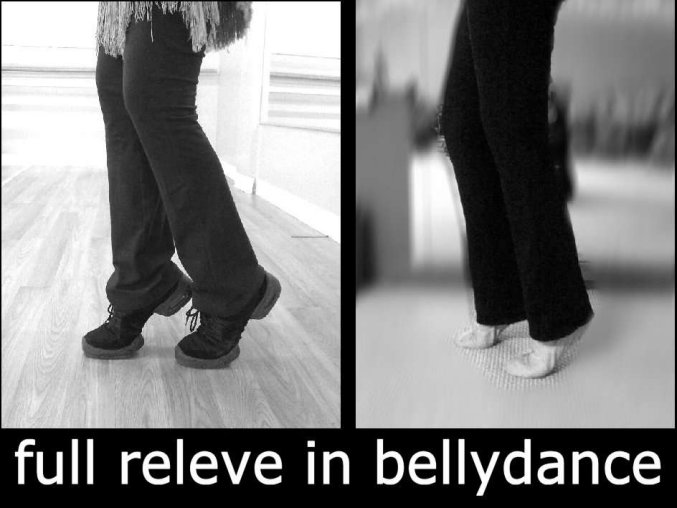Even if you are a beginner, you should start using *releve (rul- luh- vay) in your Warmup so you’ll be strong enough when you want to dance while lifted up on the ball of the foot. The reason that beginners don’t dance up on their toes is because they don’t have enough body control to stay balanced; and they also dance at a slower pace. When they gain enough body control to dance quickly, they will need to get up off their heels. So begin working on your releve now, it will become easier over time.
In the beginning, some students have a hard time actually getting into full releve simply because they just never go up on their toes, and never wear high heels. If there’s one thing that high-heeled shoes are good for, it does get your foot used to the “releve” position (but you know high heels are bad for your feet and back so only wear them for short periods of time!).
The Warmup Routine I use in my classes includes heel lifts, which take the foot into full releve, thus conditioning the foot and ankle by stretching and strengthening them. Here’s a photo showing correct full releve position:

During the Warmup and in much of the dancing in class, I check my students constantly to see how everyone is using their feet; and quite often the releve position students use is not high enough. Here’s a photo showing the wrong position:

Because I’ve learned that this half-way position isn’t good for the foot, I always urge a higher lift. You need to bring your weight UP (over the ball) of the foot, imagining that you’re wearing very high-heeled shoes. Yes, I’m a Pisces, very focused on the feet!
One of the popular belly dance steps using releve is the “flat-ball” combination, sometimes done as flat-ball-ball, or flat-ball-ball-ball (ball is the ball of the foot, meaning in releve). Look at the lovely feet of Soheir Zaki doing this step (screenshot from TheCaroVan channel):

You’ll find this position becomes more comfortable the more you use it, and in fact many steps are much easier when you keep your heels lifted - walking shimmies, and shimmies layered onto foot patterns are often easier in releve. When the pace quickens and we dance faster, our steps have to become smaller. The less foot there is on the ground, the easier it is to step quickly.
What did you think of this in-depth series of articles on our belly dancing feet? So often we only think of what’s happening between our knees and neck! But our foundation and CONNECTION to the earth is through our feet; and until we have wings, we must work to master our movements through space by using our weight, through momentum and contact with the ground.
Back to Technique Explained!